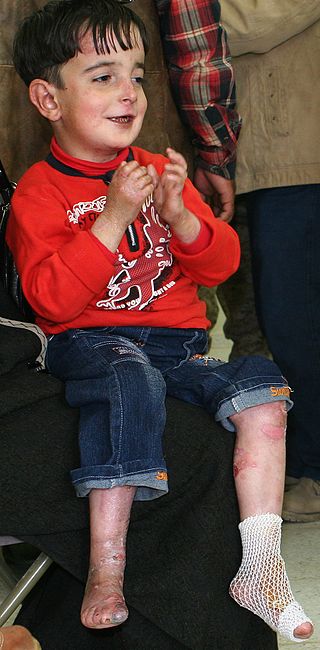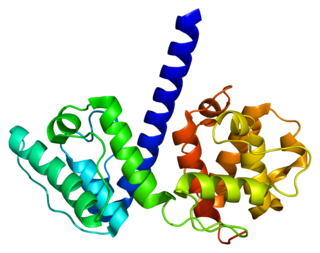Related Research Articles

Gene therapy is a medical technology which aims to produce a therapeutic effect through the manipulation of gene expression or through altering the biological properties of living cells.

Epidermolysis bullosa (EB) is a group of rare medical conditions that result in easy blistering of the skin and mucous membranes. Blisters occur with minor trauma or friction and are painful. Its severity can range from mild to fatal. Inherited EB is a rare disease with a prevalence in the United States of 8.2 per million live births. Those with mild cases may not develop symptoms until they start to crawl or walk. Complications may include esophageal narrowing, squamous cell skin cancer, and the need for amputations.

Keratin 14 is a member of the type I keratin family of intermediate filament proteins. Keratin 14 was the first type I keratin sequence determined. Keratin 14 is also known as cytokeratin-14 (CK-14) or keratin-14 (KRT14). In humans it is encoded by the KRT14 gene.

Hemidesmosomes are very small stud-like structures found in keratinocytes of the epidermis of skin that attach to the extracellular matrix. They are similar in form to desmosomes when visualized by electron microscopy, however, desmosomes attach to adjacent cells. Hemidesmosomes are also comparable to focal adhesions, as they both attach cells to the extracellular matrix. Instead of desmogleins and desmocollins in the extracellular space, hemidesmosomes utilize integrins. Hemidesmosomes are found in epithelial cells connecting the basal epithelial cells to the lamina lucida, which is part of the basal lamina. Hemidesmosomes are also involved in signaling pathways, such as keratinocyte migration or carcinoma cell intrusion.
Antisense therapy is a form of treatment that uses antisense oligonucleotides (ASOs) to target messenger RNA (mRNA). ASOs are capable of altering mRNA expression through a variety of mechanisms, including ribonuclease H mediated decay of the pre-mRNA, direct steric blockage, and exon content modulation through splicing site binding on pre-mRNA. Several ASOs have been approved in the United States, the European Union, and elsewhere.

Plectin is a giant protein found in nearly all mammalian cells which acts as a link between the three main components of the cytoskeleton: actin microfilaments, microtubules and intermediate filaments. In addition, plectin links the cytoskeleton to junctions found in the plasma membrane that structurally connect different cells. By holding these different networks together, plectin plays an important role in maintaining the mechanical integrity and viscoelastic properties of tissues.
Enzyme replacement therapy (ERT) is a medical treatment which replaces an enzyme that is deficient or absent in the body. Usually, this is done by giving the patient an intravenous (IV) infusion of a solution containing the enzyme.

Epidermolysis bullosa simplex (EBS) is a disorder resulting from mutations in the genes encoding keratin 5 or keratin 14.

Kindler syndrome is a rare congenital disease of the skin caused by a mutation in the KIND1 gene.

Keratin 5, also known as KRT5, K5, or CK5, is a protein that is encoded in humans by the KRT5 gene. It dimerizes with keratin 14 and forms the intermediate filaments (IF) that make up the cytoskeleton of basal epithelial cells. This protein is involved in several diseases including epidermolysis bullosa simplex and breast and lung cancers.

Epidermolysis bullosa dystrophica or dystrophic EB (DEB) is an inherited disease affecting the skin and other organs.

Genodermatosis is a hereditary skin disease with three inherited modes including single gene inheritance, multiple gene inheritance and chromosome inheritance. There are many different types of genodermatosis, the prevalence of genodermatosis ranges from 1 per 6000 people to 1 per 500,000 people. Genodermatosis has influence on the texture, color and structure of skin cuticle and connective tissue, specific lesion site and clinical manifestations on the body vary depending on the type. In the spite of the variety and complexity of genodermatosis, there are still some common methods that can help people diagnose. After diagnosis, different types of genodermatosis require different levels of therapy including interventions, nursing interventions and treatments. Among that, research of therapy for some new, complex and rare types are still in the developing stage. The impact of genodermatosis not only can be seen in body but also can be seen in all aspects of patients' life, including but not limited to psychological, family life, economic conditions and social activities. Accordingly, the patients need treatment, support and help in these areas.

Collagen alpha-1(VII) chain is a protein that in humans is encoded by the COL7A1 gene. It is composed of a triple helical, collagenous domain flanked by two non-collagenous domains, and functions as an anchoring fibril between the dermal-epidermal junction in the basement membrane. Mutations in COL7A1 cause all types of dystrophic epidermolysis bullosa, and the exact mutations vary based on the specific type or subtype. It has been shown that interactions between the NC-1 domain of collagen VII and several other proteins, including laminin-5 and collagen IV, contribute greatly to the overall stability of the basement membrane.

Laminin subunit gamma-2 is a protein that in humans is encoded by the LAMC2 gene.
Anchoring fibrils extend from the basal lamina of epithelial cells and attach to the lamina reticularis by wrapping around the reticular fiber bundles. The basal lamina and lamina reticularis together make up the basement membrane. Anchoring fibrils are essential to the functional integrity of the dermoepidermal junction.
Junctional epidermolysis bullosa is a skin condition characterized by blister formation within the lamina lucida of the basement membrane zone.
Lethal acantholytic epidermolysis bullosa is a fatal genetic skin disorder caused by mutations in DSP
Scioderm, acquired by Amicus Therapeutics in 2015, was a rare disease company focused on developing a treatment for Epidermolysis Bullosa (EB), a rare genetic disease characterized by extremely fragile skin and recurrent blister formation. There are currently no approved therapies for EB. Scioderm was developing a topical treatment known as SD-101, or Zorblisa, aimed at triggering wound reduction and closure, and a reduction in body surface area coverage of blisters and lesions.

Graziella Pellegrini is an Italian Professor of Cell Biology and the Cell Therapy Program Coordinator at the University of Modena and Reggio Emilia. She has developed and championed cell therapy protocols in hospitals across Italy.
Beremagene geperpavec, sold under the brand name Vyjuvek, is a gene therapy for the treatment of wounds. Beremagene geperpavec is the first approved gene therapy to use herpes-simplex virus type 1 as a vector. Beremagene geperpavec is a genetically modified herpes-simplex virus used to deliver normal copies of the COL7A1 gene to the wounds.
References
- ↑ Gorzelany JA, de Souza MP (March 2013). "Protein replacement therapies for rare diseases: a breeze for regulatory approval?". Science Translational Medicine. 5 (178): 178fs10. doi: 10.1126/scitranslmed.3005007 . PMID 23536010.
- ↑ Crunkhorn S (June 2013). "Regulatory watch: enhanced chance of success for protein replacement therapies". Nature Reviews. Drug Discovery. 12 (6): 414. doi: 10.1038/nrd4027 . PMID 23722335. S2CID 30803636.
- ↑ Labbe C (2014-02-05). "Protein Replacement Therapy Shows Promise in Treating Rare Skin Disorder". National Institute of Arthritis and Musculoskeletal and Skin Diseases. U.S. Department of Health and Human Services. Retrieved 2018-10-14.
- ↑ Wang X, Ghasri P, Amir M, Hwang B, Hou Y, Khalili M, Khilili M, Lin A, Keene D, Uitto J, Woodley DT, Chen M (July 2013). "Topical application of recombinant type VII collagen incorporates into the dermal-epidermal junction and promotes wound closure". Molecular Therapy. 21 (7): 1335–44. doi:10.1038/mt.2013.87. PMC 3704128 . PMID 23670575.